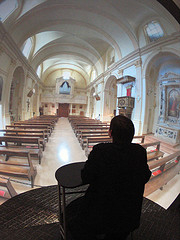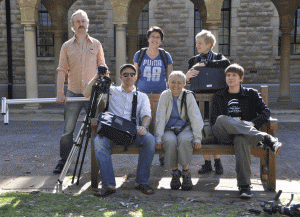When you watch a television or cinema screen, you are experiencing a film within the context of the room in which it is being shown. The viewer focuses on the screen with their central vision whilst the vast majority of their peripheral vision remains unengaged. People working in film sound, however, know about the importance of addressing the peripheries of the senses. Film sound artists use surround sound to fully engage audiences’ hearing: stereo sound gives the audience a two-dimensional window into the sonic world of the film, but effective use of surround sound places the audience inside that sonic world.

The iDome. Photographer: Eva Sprenkelder
Fulldome is the visual equivalent of this immersion. The hemispherical design of a large dome envelops your entire field of vision. You can’t see the edges of the screen, thus you exist within the world you’re watching. If a giant person is displayed in Fulldome, it makes you feel small. If a shot is taken from a rollercoaster, you feel you are moving. The challenge for DomeLab participants was how to develop techniques to effectively immerse the audience within a live-action, narrative film.
In Fulldome, you can’t rely on frame-based visual techniques to work as they do in traditional cinema. For example, the close-up shot is a technique often used in traditional film to draw attention to a particular person or object, or to connect the audience with a character. In Fulldome, the effect is completely different; a close up of a face engulfs your central vision, as well as your peripheral vision in all directions. It feels overwhelming and, quite often, menacing. To create an equivalent of a traditional close-up, you need fill only the portion of the screen directly in front of the viewer’s line of sight – 1/8 of the screen, or less.
We also needed to address issues that arose with scene transitions. Characters cannot walk off the side of a domed screen. Your only option is to have the character walk off the bottom of the hemisphere, which looks quite odd. We ‘solved’ this dilemma by using short cross-dissolves from one scene into the next (keeping the focal point of the entering scene in the same place as the exiting scene to create a continuous viewing experience) or by using theatrical-style transitions (having one scene’s key point of interest leave the observers’ central vision as a new point of interest enters, allowing the old point of interest to then fade out without the observer noticing).
I found the best way to shoot footage for Fulldome was not to convert traditional filmic techniques to the dome, but instead to convey an emotion or feeling through altering the audience’s perception of themselves within the space. The techniques mentioned above are also surprisingly useful in the creation of traditional film and artistic installation. I now think considerably more about the use of space and scale in visuals while working in these formats.
 There are other issues that affect the Dome’s suitability for live action immersive narrative. One is the Dome’s ‘sweet spot’: in the centre of the dome you get the full immersive experience, but as you move outside this zone you tend to get a distorted view of what is being projected. Another issue is ‘screen bounce’. The hemispherical screen results in bright sections of projected image being reflected, bouncing around and washing out the rest of the dome surface. We discussed possible solutions such as LED panels replacing projectors and using screens made of semi-transparent material to let light pass through rather than reflect back into the dome.
There are other issues that affect the Dome’s suitability for live action immersive narrative. One is the Dome’s ‘sweet spot’: in the centre of the dome you get the full immersive experience, but as you move outside this zone you tend to get a distorted view of what is being projected. Another issue is ‘screen bounce’. The hemispherical screen results in bright sections of projected image being reflected, bouncing around and washing out the rest of the dome surface. We discussed possible solutions such as LED panels replacing projectors and using screens made of semi-transparent material to let light pass through rather than reflect back into the dome.
While Fulldome is still in its infancy and opportunities to create experimental Fulldome films are rare, Dome Lab showed that it is possible to create cutting edge dome films for the international Fulldome festival circuit now, and with a bit of work at market awareness, planetariums throughout Australia. Personally, as an emerging artist working in multimedia, the opportunity to experiment with new formats, mediums and technologies is vital. Dome Lab has been a rewarding experience that will influence my sound and multimedia work throughout the rest of my career.
David Kirkpatrick
David Kirkpatrick is a sound and multimedia artist based in Sydney, Australia. His practice crosses the boundaries of composition and sound design, video and live visuals, and interactive installation. In 2009 he was awarded an Australia Council ArtStart Grant, followed in 2010 by support through the Australia Council’s Digital Culture Fund.
David’s participation in Dome Lab was made possible through the generous support of Screen Development Australia
Read More
 This work is licensed under a Creative Commons Attribution-NonCommercial-ShareAlike 3.0 Australia.
This work is licensed under a Creative Commons Attribution-NonCommercial-ShareAlike 3.0 Australia.






